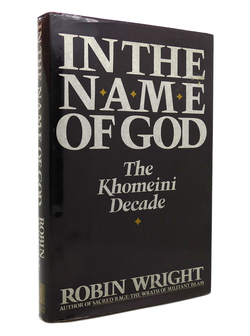 In her fine and reliable survey, Robin Wright discerns three broad eras within the decade (from February 1979 to June 1989) of Ayatollah Khomeini's rule in Iran.
In her fine and reliable survey, Robin Wright discerns three broad eras within the decade (from February 1979 to June 1989) of Ayatollah Khomeini's rule in Iran.
The first four years she portrays as a period of survival. A politically inexperienced group of mullahs had to create new institutions, then make sure these lasted. Their task was made that much more difficult given the wide hostility inspired by the Islamic Revolution. Washington seemed always to threaten, though it took few steps against Tehran; Baghdad did actually initiate a war; and the Mojahedin-e Khalq, the leading domestic opposition group, killed over a thousand government officials in one four-month period in 1981.
According to Miss Wright, the second four years (from 1983 to November 1986) marked the Islamic Republic's era of expansion. At home, the government reformed institutions from banks to schools with an eye to making them compatible with Khomeini's vision of a fundamentalist Islamic order. Abroad, Iranian forces went on the offensive against Iraq, helped Afghan fighters take on the Red Army, and developed the twin instruments of suicide terrorism and hostage-taking, directed mostly against the West.
The final two and a half years, which lasted from the revelation of the Iran/contra affair to Khomeini's death, were characterized by retreat. "The cost of the arrogance and the isolation that had been so essential to [Khomeini]'s dream had been enormous." As the Islamic Republic's failings became fully apparent, survival of the regime once again became a foremost concern. Even the lower classes in Iran no longer supported Khomeini as of old. The fervor of all but the most enthusiastic was dulled by eight years of war, steady economic decline, and a regime run by narrow-minded officials. Combat with Iraq eventually turned out so badly, Khomeini had to call off the war, an act he termed "more deadly than drinking hemlock." Though Khomeini still had plenty of kick left in him - the edict against Salman Rushdie once again showed the depth of his radicalism - the robust years of the Islamic Revolution had clearly passed by the time of his death last spring.
Looking ahead, Miss Wright suggests that the key to the regime's future lies in its priorities. For Iran's revolution to survive a second decade, she writes, it "will almost certainly have to redirect its energies, focusing less on exporting the revolution and more on domestic problems." The recipe she offers to achieve this is almost identical at home and abroad. Tehran can win more domestic support by showing greater tolerance of diverse tastes and beliefs; and it can win more foreign backing if it calls of the bellicosity and behaves according to the usual norms. In short, for it to last, "the revolution will have to come to grips with its limitations."
Although she does not analyze in detail political developments since Ayatollah Khomeini's death, Miss Wright implies that trends are favorable for stability. The Khomeini decade witnessed an interminable dispute of idealism vs. realism, purity vs. pragmatism, and the revolution vs. the state. Ali Akbar Hashemi Rafsanjani, the new president of Iran, has a key role in closing this dangerous battleground, for "just as the ayatollah personified the revolution, Rafsanjani had come [by 1988] to personify the state." It is likely, in other words, that the Iranian government will in the future pursue less radical goals.
Miss Wright's review of the Khomeini decade displays the usual strengths and weaknesses of a journalist's account. On the positive side, she writes well and provides specifics to back up theories. She also has an eye for the telling detail: the cake Oliver North carried to Iran was kosher; beards worn by Iranian soldiers render gas masks ineffective; and expropriated franchises of Kentucky Fried Chicken in Iran replaced Col. Sanders's picture with a man resembling the Islamic Republic's first president, Abol Hassan Bani Sadr.
On the negative side, In the Name of God suffers from the author's inability to speak or read the Persian language. Accordingly, the great bulk of scholarly, journalistic, and first-hand information about Iran is completely unavailable to her. Worse yet, she appears to rely only on English-language sources, so that she even lacks access to information in other European languages. (To realize how constraining this is, imagine a French journalist specializing in American affairs but not able to speak or read English!)
Too, Miss Wright is shaky when it comes to the culture and history of Iran. She fails, for example, to explain that Khomeini initiated an experiment in theological rule absolutely unprecedented in Iranian history, one nearly as alien to Iranians as it is to Americans. The Islamic Republic's future can properly be evaluated only by understanding just how profoundly Khomeini's efforts contradict Iranian cultural traditions. Indeed, familiarity with those traditions is likely to heighten the analyst's skepticism about the lasting power of Khomeini's regime.
These reservations aside, Robin Wright has produced a timely, reliable, and trustworthy account of Iran's most singular decade.